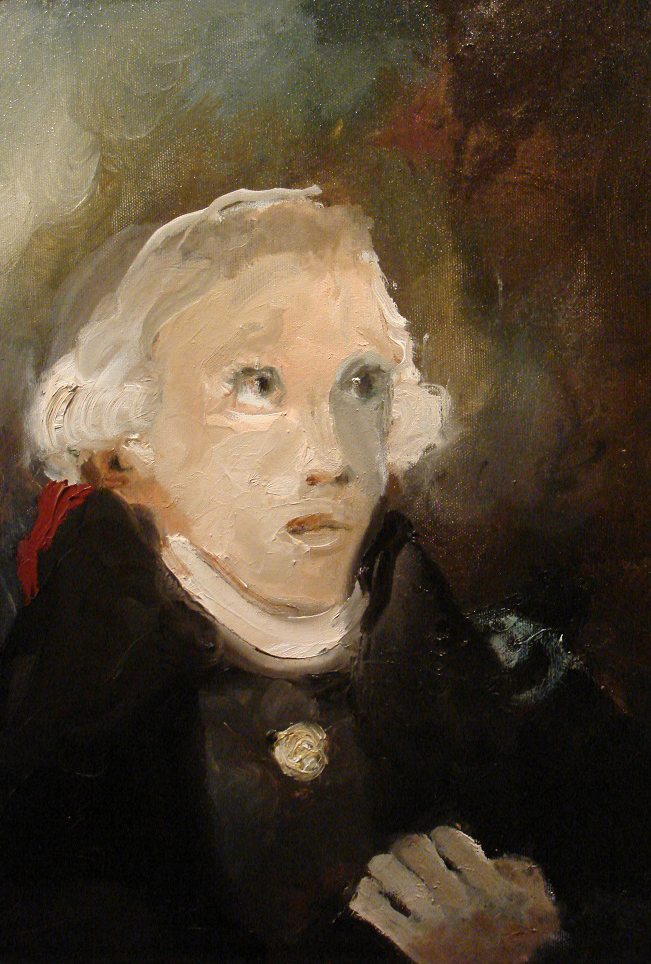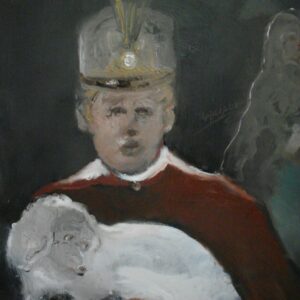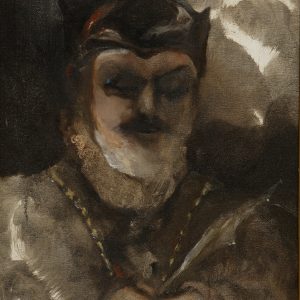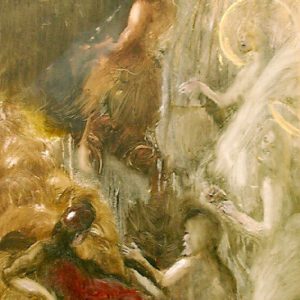Description
Artist/Maker: Kostas Kampouropoulos (1939-2018)
Object/Materials and Techniques: Oil on Canvas
Date: Painted between 2007-2016
Dimensions: H. 50 cm. x W. 40 cm.
Art style: Portraiture / Romantic Elements / Expressionistic Structures / Abstract Art
Current Location: Private collection
Curator’s note: A fictional portrait inspired by similar depictions of the legendary Russian Count.
Count Grigory Grigorievich Orlov (1734 – 1783) became an almost holy figure in Russia due to his contribution to the establishment of the legendary Empress of Russia, Catherine II The Great, at the Russian throne. He is known as a Count, Prince of the Holy Roman Empire, soldier, statesman and imperial favourite. Furthermore, he was a strong believer of the Hellenic Cause and considered as one of the main supporters of the planning of the Hellenic Revolution against the Ottoman rule, the so-called Greek Plan, that implemented some 40 years after his death (in the early 19th century between 1821-1830).
Kostas Kampouropoulos in the present work, greatly inspired by history which he was fond of studying, chose consciously to introduce one of the most significant personalities, both of the hellenic and russian history, into the legacy of what might someone would call art-historical oeuvres. In his painting, Count Orloff, is observed as a ‘watcher’ of the society, worthy of his activist reputation as regards his energies towards the dismantling of the Ottoman Empire, and the emancipation of the Christians.
In the artist’s book For the Painting (2013), he notifies that this portrait relies within the framework of a special category of commemorative works with respect to the Hellenic War of Independence against the Ottomans. Heroes, portraits, narratives and chronicles related to the widely known Struggle of his ancestral country Hellas become central focus in a high attempt to reveal the brilliant historical occasion.
However, this specific depiction of Grigory Orlov, as Kostas Kampouropoulos further describes, though unambiguously topical, offers an unexpected and challenging portrayal of the renowned Count. His form bears the marks of fall from power, in contradiction to the majority of portraits that present him in full glory.
Via the three quarter-view portraiture format, Kostas Kampouropoulos’ approach has been to betray a chain of hostile circumstances that led the Count, through particular difficult times, into collapse. The hard and demanding Mediterranean operations, the breaking up of his relationship with the Empress, the mental illness from which he suffered in his later years are only some of the circumstances that the Count was called to deal with in solitude. In some way they are reflected and indicated masterfully onto the portrait through the unaffected posture and distant gaze of the subject, plus the physical intertwining of white vague choppy brushstrokes on his appearance, in combination with a largely changeover of dark earthly colours and various versions of ‘Van Dyke’ coffee -favourite palette of the artist.
Throughout the whole creation, the very typical minimalistic practice and personal aesthetic of Kostas Kampouropoulos which reject any standard form and finish is dominant. Within the overall lack of outlines and moody hued atmosphere special emphasis is given to the diamond that the Count carries on his attires. This is one of the greatest diamonds of the world, widely known as the Orlov Diamond, which he offered to the Empress in an attempt to restore himself to her affections. Catherine The Great, after accepting, had it encrusted into the Imperial Sceptre of Russian.
The presence of such a bright and magnificent diamond onto the despairing figure of the Count aims to incorporate into the synthesis an allegorical antithesis that leads up to an introspective symbolization of the potential rise and fall of the human. The artist, far from dictating any line between both states, he masterfully embodies into the portrait a personal drama so lively true. Neither a loser nor an idol, Count Grigory Orlov, above all, is a human being with a strong life story to share of both grandeur and decrease.
Nevertheless, the sharp colour contrast of the bright face in accordance with the thoughtful intent look foreground the artist’s overarching intention to underline the timeless glory of the eminent, dynamic and revolutionary profile of the glorious Russian Count. As a result, Kostas Kampouropoulos greatly succeeds in granting the portrayal work a special sense of illusionary yet intimate encountering between the Russian Count and the viewer.
Today, the art-historical paintings by Kostas Kampouropoulos with reference to the Hellenic War of Independence make up a group of great importance in the entirety of the artist’s total output. They act catalytically as a powerful reminder of national history, plus encompass different levels of consciousness, leading to an alert cognitive state of mind.
Curator’s highlight detail: Kostas Kampouropoulos enhances the overall composition with an allure of distinct classical splendour while suggesting an accentuated dramatic aura by employing his favourite and very distinctive motif of sienna (a reddish hue) that further underscores the mysterious imperial era.
Bibliographic References:
- Κωνσταντίνος Ι. Καμπουρόπουλος, Για τη Ζωγραφική, Αθήνα, Εκδοτικός Οργανισμός Πάπυρος, 2013, p. 22, 25, 231, pp. 78-86.
- Christopher Montague Woodhouse, Modern Greece: A Short History, London, Faber and Faber, 1968.
- Catherine June Head, The portrait of An Empress, New York, Viking Press, 1935.
- John T. Alexander, Catherine the Great: Life and Legend, New York, Oxford University Press, 1989
- Thomas Baran, Russia Reads Rousseau, 1762-1825, Evanston, IL: Northwestern University Press, 2002.
- Anna Malecka, Did Orlov buy the Orlov?, Gems and Jewelerry, July 2014, vol 23, no. 6, pp. 10-12.





